tow Hyundai Ioniq Electric 2017 Service Manual
[x] Cancel search | Manufacturer: HYUNDAI, Model Year: 2017, Model line: Ioniq Electric, Model: Hyundai Ioniq Electric 2017Pages: 582, PDF Size: 37.73 MB
Page 481 of 582
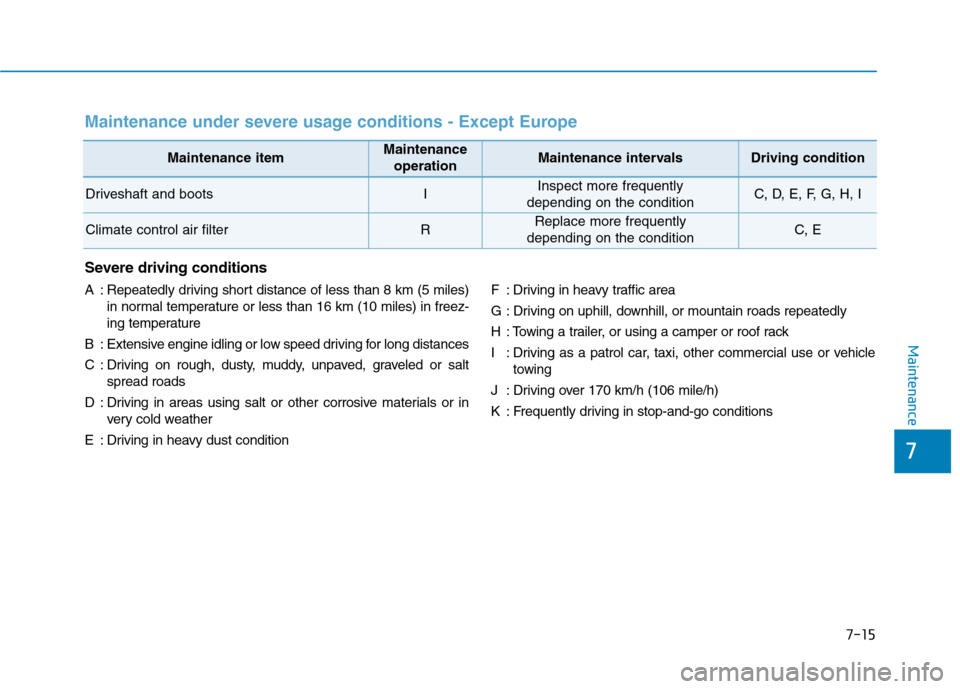
7-15
7
Maintenance
Maintenance itemMaintenance operationMaintenance intervalsDriving condition
Driveshaft and bootsIInspect more frequently
depending on the conditionC, D, E, F, G, H, I
Climate control air filterRReplace more frequently
depending on the conditionC, E
Maintenance under severe usage conditions - Except Europe
Severe driving conditions
A : Repeatedly driving short distance of less than 8 km (5 miles) in normal temperature or less than 16 km (10 miles) in freez-
ing temperature
B : Extensive engine idling or low speed driving for long distances
C : Driving on rough, dusty, muddy, unpaved, graveled or salt spread roads
D : Driving in areas using salt or other corrosive materials or in very cold weather
E : Driving in heavy dust condition F : Driving in heavy traffic area
G : Driving on uphill, downhill, or mountain roads repeatedly
H : Towing a trailer, or using a camper or roof rack
I : Driving as a patrol car, taxi, other commercial use or vehicle
towing
J : Driving over 170 km/h (106 mile/h)
K : Frequently driving in stop-and-go conditions
Page 484 of 582
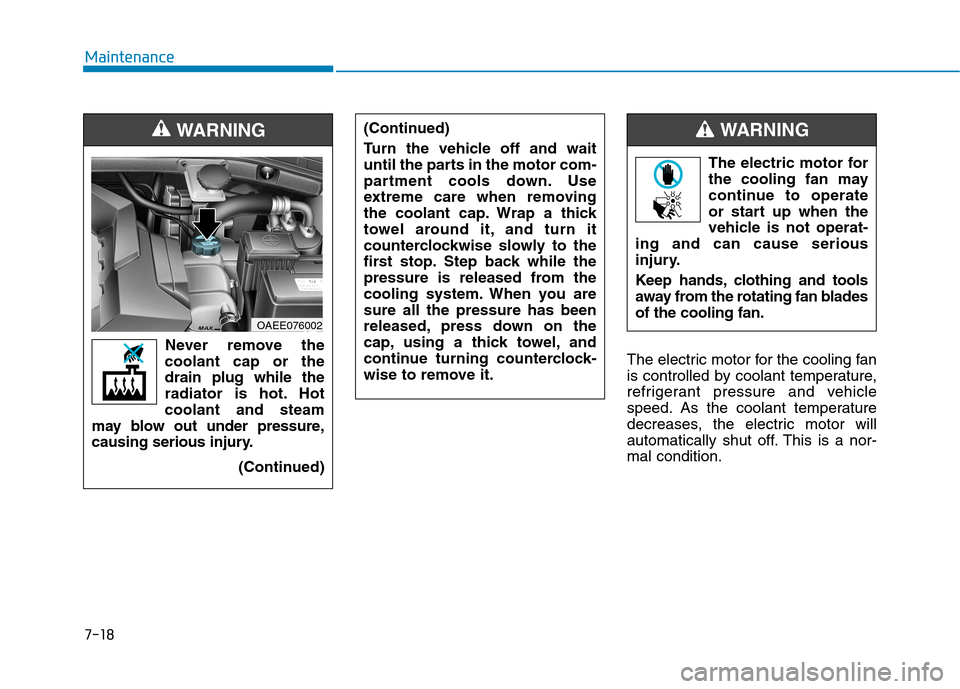
7-18
Maintenance
The electric motor for the cooling fan
is controlled by coolant temperature,
refrigerant pressure and vehicle
speed. As the coolant temperature
decreases, the electric motor will
automatically shut off. This is a nor-mal condition.
Never remove the
coolant cap or thedrain plug while the
radiator is hot. Hotcoolant and steam
may blow out under pressure,
causing serious injury.
(Continued)
WARNING
OAEE076002 The electric motor for
the cooling fan may
continue to operate
or start up when the
vehicle is not operat-
ing and can cause serious
injury.
Keep hands, clothing and tools
away from the rotating fan bladesof the cooling fan.
WARNING (Continued)
Turn the vehicle off and wait
until the parts in the motor com-
partment cools down. Use
extreme care when removing
the coolant cap. Wrap a thick
towel around it, and turn it
counterclockwise slowly to the
first stop. Step back while the
pressure is released from the
cooling system. When you aresure all the pressure has been
released, press down on the
cap, using a thick towel, and
continue turning counterclock-
wise to remove it.
Page 486 of 582
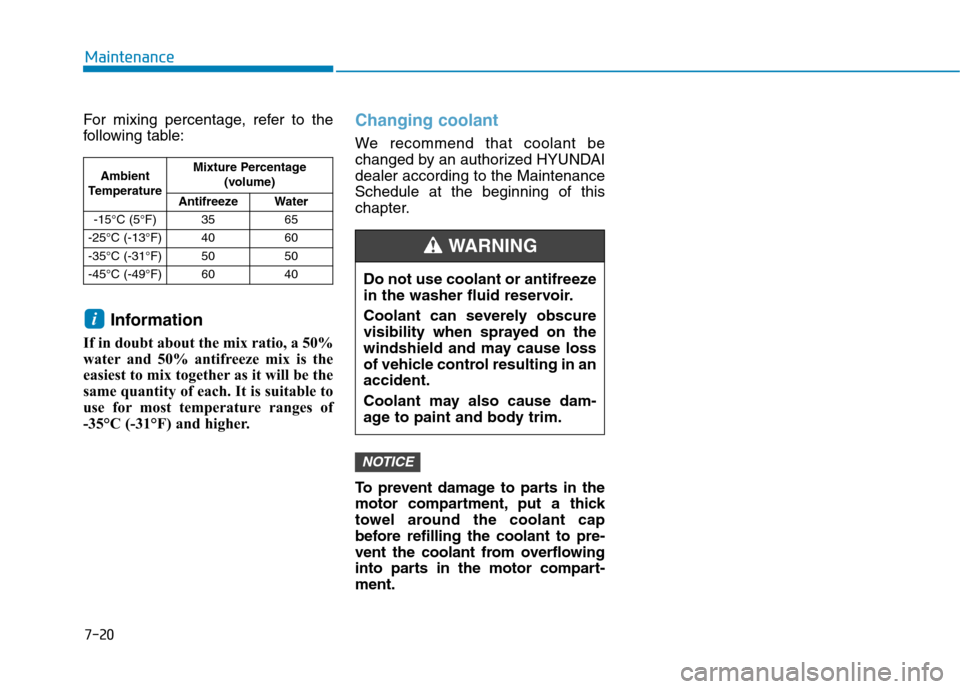
7-20
Maintenance
For mixing percentage, refer to the
following table:Information
If in doubt about the mix ratio, a 50%
water and 50% antifreeze mix is the
easiest to mix together as it will be the
same quantity of each. It is suitable to
use for most temperature ranges of
-35°C (-31°F) and higher.Changing coolant
We recommend that coolant be
changed by an authorized HYUNDAIdealer according to the MaintenanceSchedule at the beginning of this
chapter.
To prevent damage to parts in the
motor compartment, put a thick
towel around the coolant cap
before refilling the coolant to pre-
vent the coolant from overflowing
into parts in the motor compart-ment.
NOTICE
i
Do not use coolant or antifreeze
in the washer fluid reservoir.
Coolant can severely obscure
visibility when sprayed on the
windshield and may cause loss
of vehicle control resulting in anaccident.
Coolant may also cause dam-
age to paint and body trim.
WARNING
Ambient
Temperature Mixture Percentage
(volume)
Antifreeze Water
-15°C (5°F) 35 65
-25°C (-13°F) 40 60
-35°C (-31°F) 50 50
-45°C (-49°F) 60 40
Page 566 of 582
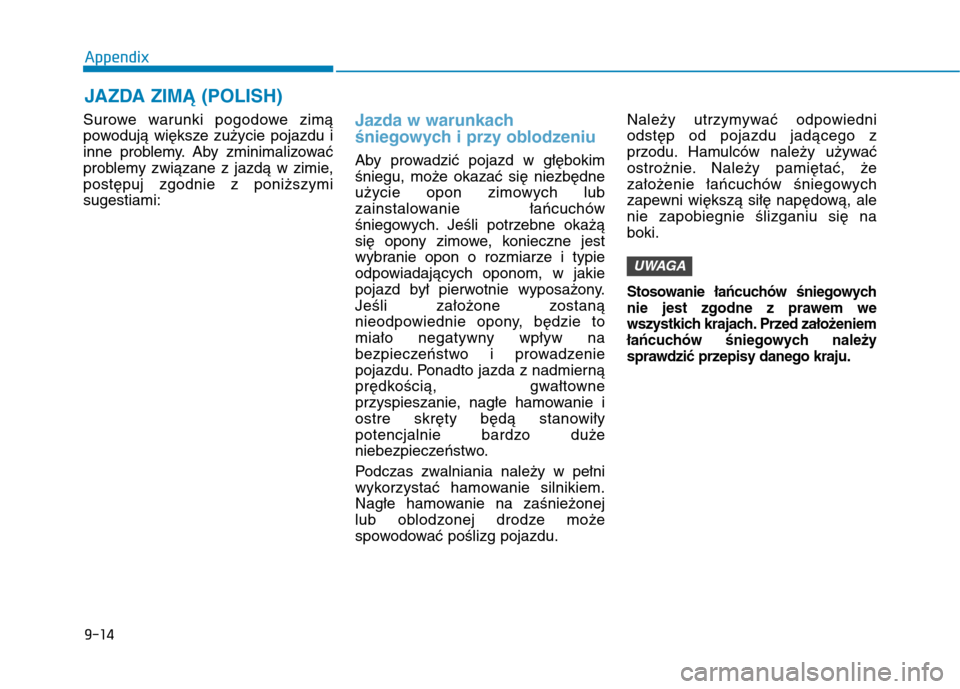
JAZDA ZIMĄ (POLISH)
9-14
Appendix
Surowe warunki pogodowe zimą
powodują większe zużycie pojazdu i
inne problemy. Aby zminimalizować
problemy związane z jazdą w zimie,postępuj zgodnie z poniższymisugestiami:Jazda w warunkach
śniegowych i przy oblodzeniu
Aby prowadzić pojazd w głębokim
śniegu, może okazać się niezbędne
użycie opon zimowych lub
zainstalowanie łańcuchów
śniegowych. Jeśli potrzebne okażą
się opony zimowe, konieczne jest
wybranie opon o rozmiarze i typie
odpowiadających oponom, w jakie
pojazd był pierwotnie wyposażony.
Jeśli założone zostaną
nieodpowiednie opony, będzie to
miało negatywny wpływ na
bezpieczeństwo i prowadzenie
pojazdu. Ponadto jazda z nadmierną
prędkością, gwałtowne
przyspieszanie, nagłe hamowanie i
ostre skręty będą stanowiły
potencjalnie bardzo duże
niebezpieczeństwo.
Podczas zwalniania należy w pełni
wykorzystać hamowanie silnikiem.
Nagłe hamowanie na zaśnieżonej
lub oblodzonej drodze może
spowodować poślizg pojazdu.Należy utrzymywać odpowiedniodstęp od pojazdu jadącego z
przodu. Hamulców należy używać
ostrożnie. Należy pamiętać, że
założenie łańcuchów śniegowych
zapewni większą siłę napędową, alenie zapobiegnie ślizganiu się naboki.
Stosowanie łańcuchów śniegowych
nie jest zgodne z prawem we
wszystkich krajach. Przed założeniem
łańcuchów śniegowych należy
sprawdzić przepisy danego kraju.
UWAGA
Page 567 of 582

Opony zimowe
Kiedy zakładane są opony zimowe,
należy upewnić się, że są to opony
radialne o takim samym rozmiarze i
zakresie obciążeń co pierwotne
opony pojazdu. Opony zimowe należy
zakładać na wszystkie cztery koła
pojazdu, by we wszystkich
warunkach pogodowych pojazd
pozwalał się prowadzić równomiernie.
Należy pamiętać, że przyczepność
zapewniana przez opony zimowe na
suchej drodze może nie być równie
wysoka jak przyczepność
pierwotnych opon pojazdu. Pojazd
należy prowadzić ostrożnie nawet
wtedy, gdy drogi są oczyszczone. Aby
poznać informacje na temat
zalecanych ograniczeń prędkości dla
danych opon, należy skontaktować
się ze sprzedawcą opon.
Opon okolcowanych nie należyzakładać bez uprzedniegosprawdzenia w przepisach lokalnych, stanowych i miejskich, czy na ichużycie nie są nałożone ograniczenia.
Łańcuchy śniegowe
(przeciwpoślizgowe)
Ponieważ ścianki boczne opon
radialnych są cieńsze, założenie
niektórych rodzajów łańcuchów
śniegowych może spowodować ich
uszkodzenie. Z tego względu zaleca
się korzystanie z opon zimowych
zamiast łańcuchów śniegowych.
Łańcuchów śniegowych nie należyzakładać w pojazdach, które są
wyposażone w felgi aluminiowe,
ponieważ mogą one powodować
uszkodzenia felg. Jeśli użycie
łańcuchów śniegowych jest ni ezbędne,
należy zastosować łańcuchy drutowe o
grubości poniżej 12 mm.
9-15
A
Appendix
Rozmiar opon zimowych
Opony zimowe powinny mieć
rozmiar i typ odpowiadający
standardowym oponom pojazdu.
Jeśli tak nie jest, może to mieć
negatywny wpływ na
bezpieczeństwo i prowadzeniepojazdu.
OSTRZEŻENIE
OAEE056015
Page 569 of 582
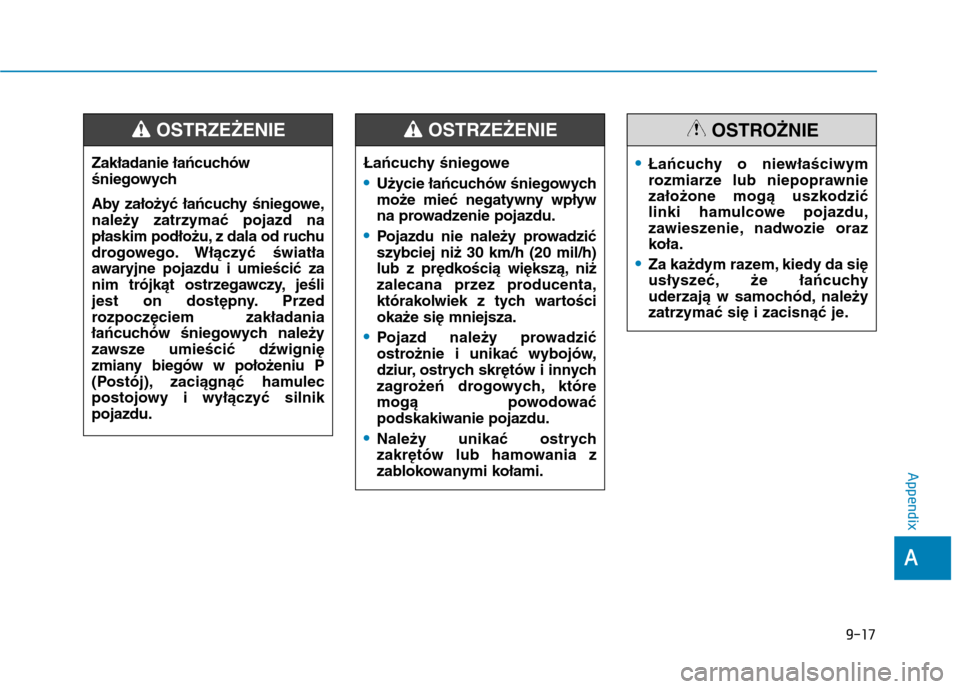
9-17
A
Appendix
Zakładanie łańcuchów
śniegowych
Aby założyć łańcuchy śniegowe, należy zatrzymać pojazd na
płaskim podłożu, z dala od ruchu
drogowego. Włączyć światła
awaryjne pojazdu i umieścić za
nim trójkąt ostrzegawczy, jeśli
jest on dostępny. Przed
rozpoczęciem zakładania
łańcuchów śniegowych należy
zawsze umieścić dźwignię
zmiany biegów w położeniu P
(Postój), zaciągnąć hamulec
postojowy i wyłączyć silnikpojazdu.
OSTRZEŻENIE
Łańcuchy śniegowe
•Użycie łańcuchów śniegowych
może mieć negatywny wpływ
na prowadzenie pojazdu.
•Pojazdu nie należy prowadzić szybciej niż 30 km/h (20 mil/h)
lub z prędkością większą, niż
zalecana przez producenta,
którakolwiek z tych wartości
okaże się mniejsza.
•Pojazd należy prowadzić
ostrożnie i unikać wybojów,
dziur, ostrych skrętów i innych
zagrożeń drogowych, które
mogą powodowaćpodskakiwanie pojazdu.
•Należy unikać ostrych
zakrętów lub hamowania z
zablokowanymi kołami.
OSTRZEŻENIE
•Łańcuchy o niewłaściwym
rozmiarze lub niepoprawnie
założone mogą uszkodzić
linki hamulcowe pojazdu,
zawieszenie, nadwozie oraz
koła.
•Za każdym razem, kiedy da się
usłyszeć, że łańcuchy
uderzają w samochód, należy
zatrzymać się i zacisnąć je.
OSTROŻNIE
Page 574 of 582

I-5
Easy access function .....................................................3-14
ECO guide ....................................................................3-37
ECO mode ....................................................................5-38
Electric chromic mirror (ECM) ....................................3-18
Electric power steering (EPS) ......................................3-15
Electric vehicle specifications ........................................8-2
Electronic parking brake (EPB) ...................................5-20
Electronic stability control (ESC) ................................5-31
Emergency towing ........................................................6-24
EPB (Electronic Parking Brake)...................................5-20
Explanation of scheduled maintenance items ..............7-16
Exterior care .................................................................7-71
Exterior overview
Front view ....................................................................1-2
Rear view .....................................................................1-4
Flat tire Tire Mobility Kit (TMK) ...........................................6-15
Floor mat anchor(s) ....................................................3-123
Fluid Brake fluid .................................................................7-21
Washer fluid ...............................................................7-22 Front seat adjustment......................................................2-7
Adjusting the height up and down.............................2-17
Forward and rearward adjustment .............................2-18
Manual adjustment.......................................................2-8
Front seat headrests
Power adjustment.......................................................2-10
Removal/Reinstall......................................................2-18
Seatback pocket .........................................................2-13
Fuse switch ...................................................................7-44
Fuse/relay panel description Battery terminal cover ...............................................7-56
Instrument panel fuse panel .......................................7-45
Motor compartment fuse panel ..................................7-51
Fuses .............................................................................7-42 Fuse switch ................................................................7-44
Fuse/relay panel description ......................................7-45
Instrument panel fuse replacement ............................7-43
Motor compartment panel fuse replacement .............7-44
Multi fuse ...................................................................7-45
Gauges and meters........................................................3-37
Glove box....................................................................3-117
Gross vehicle weight ......................................................8-5
I
Index
E
F
G
Page 579 of 582
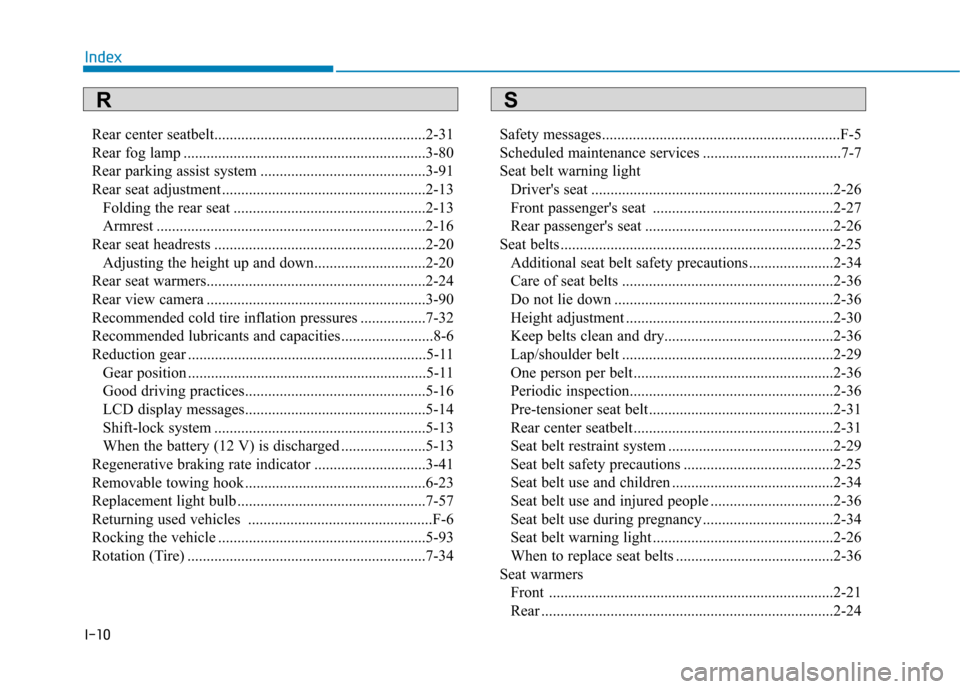
I-10Rear center seatbelt.......................................................2-31
Rear fog lamp ...............................................................3-80
Rear parking assist system ...........................................3-91
Rear seat adjustment .....................................................2-13
Folding the rear seat ..................................................2-13
Armrest ......................................................................2-16
Rear seat headrests .......................................................2-20 Adjusting the height up and down.............................2-20
Rear seat warmers.........................................................2-24
Rear view camera .........................................................3-90
Recommended cold tire inflation pressures .................7-32
Recommended lubricants and capacities........................8-6
Reduction gear ..............................................................5-11 Gear position ..............................................................5-11
Good driving practices...............................................5-16
LCD display messages...............................................5-14
Shift-lock system .......................................................5-13
When the battery (12 V) is discharged ......................5-13
Regenerative braking rate indicator .............................3-41
Removable towing hook ...............................................6-23
Replacement light bulb .................................................7-57
Returning used vehicles ................................................F-6
Rocking the vehicle ......................................................5-93
Rotation (Tire) ..............................................................7-34 Safety messages..............................................................F-5
Scheduled maintenance services ....................................7-7
Seat belt warning light
Driver's seat ...............................................................2-26
Front passenger's seat ...............................................2-27
Rear passenger's seat .................................................2-26
Seat belts .......................................................................2-25 Additional seat belt safety precautions ......................2-34
Care of seat belts .......................................................2-36
Do not lie down .........................................................2-36
Height adjustment ......................................................2-30
Keep belts clean and dry............................................2-36
Lap/shoulder belt .......................................................2-29
One person per belt ....................................................2-36
Periodic inspection.....................................................2-36
Pre-tensioner seat belt ................................................2-31
Rear center seatbelt ....................................................2-31
Seat belt restraint system ...........................................2-29
Seat belt safety precautions .......................................2-25
Seat belt use and children ..........................................2-34
Seat belt use and injured people ................................2-36
Seat belt use during pregnancy ..................................2-34
Seat belt warning light ...............................................2-26
When to replace seat belts .........................................2-36
Seat warmers Front ..........................................................................2-21
Rear ............................................................................2-24
Index
RS
Page 581 of 582

I-12Tailgate .........................................................................3-33
Tailgate room lamp .......................................................3-85
Theft-alarm system .......................................................3-12
Tilt steering / Telescope steering ..................................3-16
Tire chains ....................................................................5-97
Tire load and speed capacity ..........................................8-5
Tire Mobility Kit (TMK) ..............................................6-15
Tire pressure monitoring system (TPMS) ......................6-9
Tire rotation ..................................................................7-34
Tire specification and pressure label ..............................8-8
Tires and wheels ...........................................................7-31
Checking tire inflation pressure.................................7-33
Low aspect ratio tires.................................................7-40
Recommended cold tire inflation pressures ..............7-32
Tire care .....................................................................7-31
Tire maintenance........................................................7-36
Tire replacement ........................................................7-35
Tire rotation ...............................................................7-34
Tire sidewall labeling.................................................7-36
Tire traction................................................................7-36
Wheel alignment and tire balance .............................7-35
Wheel replacement .............................................7-36, 8-4
Towing ..........................................................................6-22
Trip computer ...............................................................3-73 Average fuel economy ...............................................3-74
Average vehicle speed ...............................................3-74 Digital speedometer ...................................................3-75
Driving Info display...................................................3-76
Elapsed time...............................................................3-74
Energy flow................................................................3-76
Instant fuel economy .................................................3-74
Tripmeter....................................................................3-74
Turn signals ..................................................................3-79
User settings mode .......................................................3-69
Vanity mirror lamp .......................................................3-86
Vehicle certification label ...............................................8-7
Vehicle identification number (VIN)..............................8-7
Vehicle modification.......................................................F-6
Vehicle stability management (VSM) ..........................5-35
Vehicle weight ............................................................5-101 Overloading .............................................................5-101
Warning and indicator lights ........................................3-41 Air bag warning light.................................................3-43
Anti-lock Brake System (ABS) warning light ..........3-45
AUTO HOLD indicator light ....................................3-48
Autonomous Emergency Braking (AEB) warning light .3-52
Charging indicator .....................................................3-42
Index
T
U
V
W